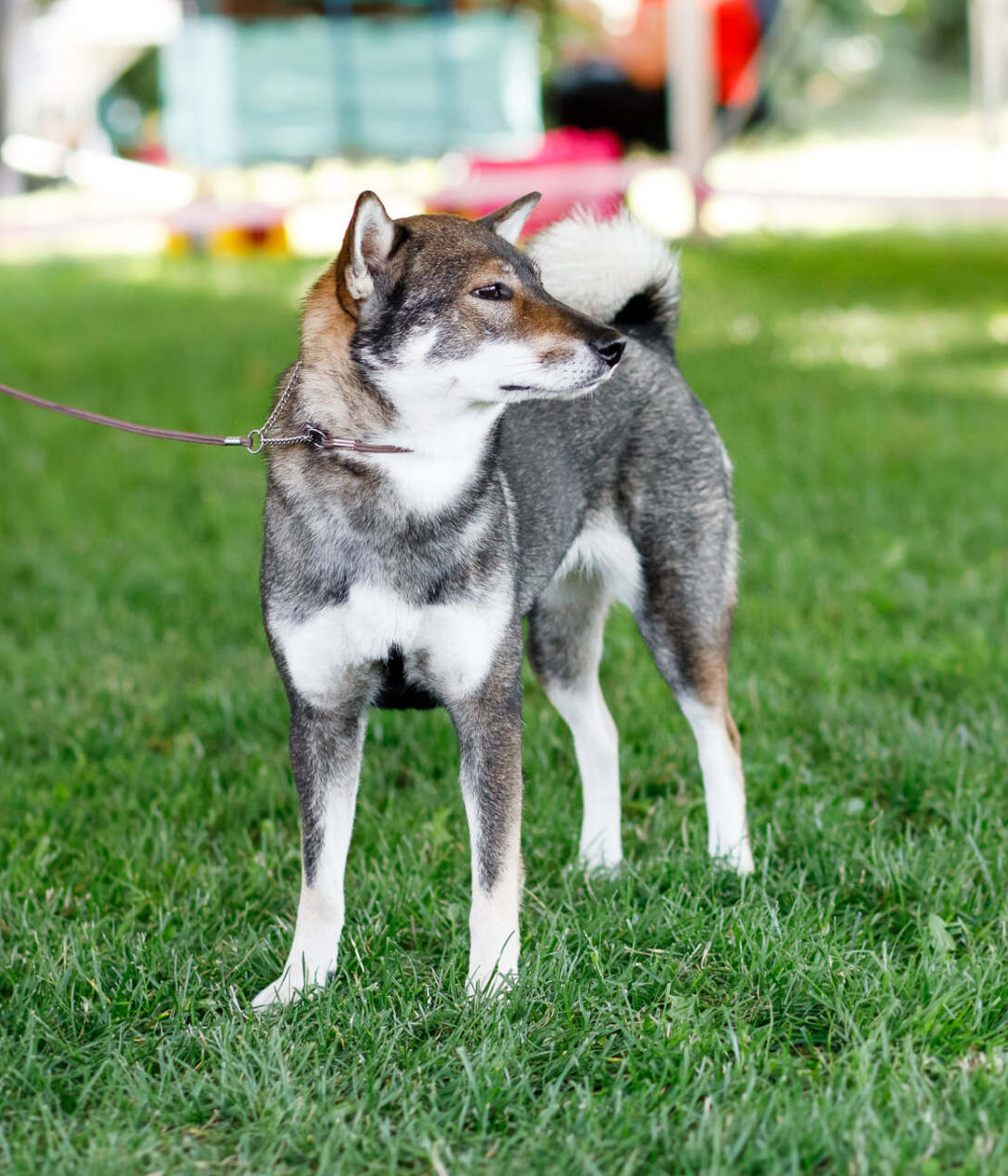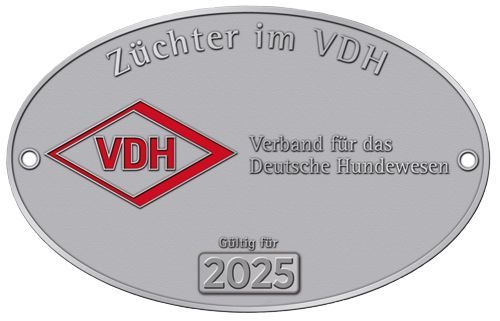Ablauf und Grundlagen einer Ausstellung/Show
Nachfolgend für Interessierte ein grober Einblick in die Glitzerwelt der Hunde. Was sind Ausstellungen?
Die Hunde werden nach Geschlecht und Altersklassen unterschieden.
Einteilung der Altersklassen: Babyklasse 16 Wochen bis 6 Monate
Jüngstenklasse 6 - 9 Monate
Jugendklasse 9 - 18 Monate
Zwischenklasse 15 - 24 Monate
Offene Klasse ab 15 Monate
Veteranenklasse ab 8 Jahre
Championklasse mit bestätigten FCI anerkannten Championtitel
Gebrauchshundeklasse ab 15 Monate mit bestätigten
Ausbildungs-/Leistungsnachweis
Sonderklassen: Zuchtgruppe mindestens 3 Hunde aus dem gleichen Zwinger bzw. mit
gleichen Züchter
Paarklasse 1 Rüde und 1 Hündin im Eigentum des Ausstellers.
Suche des idealtypischen Paars.
Nachzuchtgruppe sämtliche Nachkommen eines Rüden oder einer Hündin, aus
mindestens 5 Nachkommen aus mindestens 2 Würfen.
Voraussetzung für die Sonderklassen ist am gleichen Tag die Mindestbewertung von "gut" der teilnehmenden Hunde.
Es werden nicht immer Baby- und Jüngstenklassen angeboten! Teilweise werden auch Amateurshows angeboten. Dort darf jeder Hund einfach aus Spaß mitmachen :)
An den großen Ausstellungen vom VDH dürfen nur Hunde mit VDH bzw. FCI anerkannter Ahnentafel teilnehmen. Richten andere Drittverbände Ausstellungen aus kann es andere Eintrittsbedingungen geben. Deshalb bitte die jeweiligen Ausschreibungen beachten! Ahnentafel ist nicht gleich Ahnentafel. Gütesiegel ist und bleibt die FCI!
Der Hund sollte umgänglich sein. Der Richter/in muss problemlos den Hund anfassen und kontrollieren können. Wichtig ist vor allem die Zahnkontrolle und beim Rüden die Kontrolle der Hoden.
Kleine Hunde werden dazu auf Tischen begutachtet.
Im Ring werden die Hunde erst einzeln beurteilt. Der Richter/in sagt einem, wie er/sie den Hund sehen möchte (gerade, diagonal, eine runde im Kreis - ggf. auch mehrmals). Sind alle Hunde einzeln beurteilt, geht es ins stechen und die gesamte Gruppe wird bewertet.
Die Beurteilung erfolgt: V - Vorzüglich
SG - Sehr gut
G - Gut
Ggd - Genügend
Disq. - Disqualifiziert
In der Jüngstenklasse: vv - vielversprechend
vsp - versprechend
wv - wenig versprechend
Hunde denen keine Note angetragen werden kann, werden "ohne Bewertung" aus dem Ring entlassen mit Begründung in der Beurteilung. "Zurückgezogen" sind Hunde, welche vor Beurteilung den Ring verlassen und "nicht erschienen" sind Hunde welche nicht zeitgerecht im Ring vorgeführt wurden.
Grundsätzliche Ausschlußkriterien sind u. a. folgende Fehler für alle Hunde und Rassen:
- Zahnfehler wie Vorbiß oder Rückbiß
- Albinusmus
- Knickrute
- fehlende Hoden oder kastrierte Rüden (auch chemisch)
- Aggressivität
- mangelndes Geschlechtsgepräge
- Nutzung von verbotenen Hilfsmitteln wie Quitschis
Weitere Abstufungen erfolgen dann mit Zahlen 1, 2, 3 usw.
Hunde mit der Beurteilung V1 laufen mit den anderen Altersklassen der Rasse um das BOB ("Best of Breed") und das BOS ("Best of opposite Sex"). Der BOB Hund qualifiziert sich für den Ehrenring. Dort tritt der gegen seine Gruppe an. Es gibt insgesamt 10 Gruppen, in welche alle Rassen unterteilt werden.
Die Gruppen sind wie folgt definiert:
I Hütehunde und Treibhunde (ohne Schweizer Sennenhunde)
Sektion 1 Schäferhunde
Sektion 2 Treibhunde
II Pinscher u. Schnauzer - Molossoide - Schweizer Sennenhunde & andere Rassen
Sektion 1 Pinscher und Schnauzer
Sektion 2 Molossoide
Sektion 3 Schweizer Hunde
III Terrier
Sektion 1 hochläufige
Sektion 2 niederläufige
Sektion 3 bullartige
Sektion 4 zwerg
IV Dachshunde (Teckel/Dackel)
V Spitze und Hunde vom Urtyp
Sektion 1 nordische Schlittenhunde
Sektion 2 nordische Jagdhunde
Sektion 3 nordische Wach- und Hütehunde
Sektion 4 europäische Spitze
Sektion 5 asiatische Spitze und verwandte Rassen
Sektion 6 Urtyp
Sektion 7 Urtyp- Hunde zu jagdlichen Verwendung
VI Laufhunde, Schweißhunde und verwandte Rassen
Sektion 1 Laufhunde
Sektion 2 Schweißhunde
Sektion 3 verwandte Rassen
VII Vorstehhunde
Sektion 1 kontinentale
Sektion 2 britische und irische
VIII Apportierhunde - Stöberhunde - Wasserhunde
Sektion 1 Apportierhunde
Sektion 2 Stöberhunde
Sektion 3 Wasserhunde
IX Gesellschafts- und Begleithunde
Sektion 1 Bichons und verwandte Rassen
Sektion 2 Pudel
Sektion 3 kleine belgische Hunderassen
Sektion 4 haarlose Rassen
Sektion 5 tibetanische Rassen
Sektion 6 Chihuahueno
Sektion 7 englische Gesellschaftsspaniel
Sektion 8 japanische Spaniel und Pekinesen
Sektion 9 kontinentaler Zwergspaniel, Russischer Toy u. Prager Rattler
Sektion 10 Komfohrländer
Sektion 11 kleine doggenartige Hunde
X Windhunde
Sektion 1 langhaarige oder befederte
Sektion 2 rauhhaarige
Sektion 3 kurzhaarige
Dies Sektionen werden teilweise nochmals unterteilt. Dies haben wir uns der Übersicht wegen erspart.
Der Sieger seiner Gruppe kämpft dann geben die anderen Gruppen um das BIS ("Best in Show").
Das ist in groben Zügen der Ablauf und die Unterteilung einer Show.
Achievements or titles, ribbons and trophies
An opinion from us, the unimportant side. Nevertheless, we will briefly comment on the topic.
We also attend shows, like many breeders and interested parties. Of course, some take it more seriously, others less so.
Why do we visit exhibitions?
The most important reason for us is educational work. We want to offer interested people the opportunity to get to know the breed in their own community without much effort.
Another important reason for this is mating abroad or suitability as a stud dog.
We're talking about our club now. If I want to breed with a male from abroad, he must submit at least three show reports in addition to his health test. These reports assess his phenotype, his appearance/conformation. This means that you are forced to attend shows. In other clubs, these are also required for a breeding license (ZZL).
In some associations, some exhibition certificates are even mandatory for participation in a ZZL.
We've been attending many shows now. We've met some really great people. You always meet loved ones, friends, and other breeders here to chat with. The warmth is indescribable!
The Dogged Part - Show
Achievements/titles, trophies, and ribbons are NOTHING. They say absolutely nothing about the dog. For us, all our children are the best. As is the case with others, your dog is the best.
Unfortunately, a "madness" is still being practiced. So-called premium dogs, star dogs, or the like, which only carry titles but have poor inheritance patterns, can destroy a breed.
Much more attention should be paid to health and character, not to restrict the genetic makeup, etc. Ribbons, titles, and trophies don't say anything about this. Quite the opposite. The saying "Beauty is in the eye of the beholder" applies here. We always talk about an objective dimension that is subjectively evaluated.
Surely some will now say, "There is a standard, after all." However, this is a double-edged sword. There simply isn't enough time to accurately assess and review the standard, or to consult it in case of doubt, which brings us back to the above statement. Furthermore, the judge's word is inviolable.
We'd like to point out that appraisals must be written like employment references. Therefore, everything in them usually sounds positive, but with a hidden message.
My dear little negative example, Noshi. You can read Noshi's story in more detail on his website. Very briefly for everyone... Our dear Noshi is sick. He has HD E, and you can see it even when he runs. We are his third owners and took on this initially unworldly dog when he was just over a year old. Nevertheless, we compete with him in the ring, and he wins. He is not suitable for breeding, however. We do this to achieve better resocialization! Noshi's example shows that his victories say nothing about him personally; they are merely decoration.
Far more beautiful than victories, ribbons, and titles are touching gestures, because they simply demonstrate what we want to convey. In this spirit, we would like to highlight the following lines from our exhibition reports:
- Report: 06.07.2019 - SG1 "...very friendly nature, good contact with the exhibitor"
2nd report: August 25, 2019 - V 2 "... good temperament - free movement"



All pictures are of Adele Eckelmann during a show.
I think something like this is simply priceless. Fun and no pressure!






